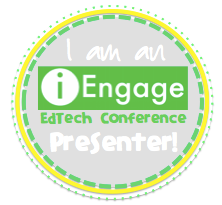Session 5: Differentiating to Support English Language Learners
This session started out with a few laughs. Since I attended the retreat in the Chicagoland area, the presenter, Kristi McCullough, began sharing a few terms that may get interpreted differently in Chicago by English language learners. Below are a few of my favorites from Kristi's presentation. If you're from Chicago, you may have experienced these firsthand! :) Click the image to view the rest of the terms.
We were then provided with a little background on WIDA. WIDA is a partnership of US state departments of education that develops learning standards for English language learners (ELLs). Students can't just sit in the corner doing a puzzle while the others, for example, learn about the life cycle. We were told 250 minutes of embedded learning in a new language is required, which means all teachers need to embed strategies within content instruction in order for students to fulfill the 250 minutes. Teachers should not wait to teach kids content until they have learned English. We have to continue to teach ELLs in the content areas as they progress in English.
ELLs progress through stages to grasp the English language, starting with listening, then moving on to speaking, reading and writing. ELLs are not necessarily starting from square one in the language department. They can be highly diverse and have a variety of background experiences. ELLs may have some academic language, but struggle having a conversation. On the other hand, ELLs may struggle with academic language, but can comfortably uphold a conversation with others. They must perceive their talking, reading and writing in a new language as meaningful. It is imperative learning a new language be rooted in a variety of meaningful discussions, which teachers can provide in their classrooms.
We all know it is not plausible for teachers to learn every language that may enter their classrooms, but all teachers play a critical role in supporting the language development of ELLs. Students can greatly benefit from teachers who learn about ELLs' home cultures, value their linguistic diversity and acquire instructional approaches to support them. We can not solely rely on ESL teachers to support ELLs, so here are a handful of ways mainstream teachers can support them:
- Focus on a set of academic vocabulary
- Use multiple modalities
- Teach independent strategies
- Integrate oral and written instruction
- Utilize menor texts (Smekens Education 2015)
It was recommended at the retreat, teachers choose vocabulary-building texts for students to use. The texts should have the ability to connect to units of study happening in the classroom. Texts that can be discussed from a variety of perspectives are also important. NewsELA is a wonderful, FREE online resource students can use to locate current news articles. The site provides texts that are brief, interesting and engaging for students.
 |
| Source |
Once academic words have been determined with the support of The Vocab Determinator, teachers should introduce them with the following 4-Step format:
Introduce an Academic Word in 4 Steps:
Teacher-led Introduction
- Teacher explains a word in simplistic terms using prompts, such as Someone who...Something that...
- Teacher ties the word to an example relevant to the students
- Teacher connects it to the text
- Students explain the word to a partner with Turn & Talk (Smekens Education 2015)
Use Multiple Modalities to Teach Vocabulary:
Concept sorts are powerful ways to introduce vocabulary. They are used before reading a text and can be done with individuals, small groups or in a whole class setting. Concept sorts allow students the opportunity to have repeated practice with vocabulary terms. They help students better grasp the meaning of the terms because the terms are being placed into categories based on meaning. Students can also sort important details from content areas, such as terms, pictures, text features and quotes from a text. The following video clip was suggested at the retreat. It demonstrates a worthwhile activity called List-Group-Label.
Games, such as HedBandz, along with Apps like Charades! Kids and Heads Up!, are also suggested as fun activities to get kids talking and discussing terms. One of my favorites that was not mentioned at the retreat, but is still engaging and entertaining, is Educational Insights Blurt.
If you would rather create your own game, try Headbands (teacher-made version), using the instructions and variations below. Students can ask questions or act out and guess vocabulary words of your choice. Using KitzKikz, a FREE card-generating site, can help you quickly create vocabulary questions cards for your students when playing Headbands!
Concept sorts are powerful ways to introduce vocabulary. They are used before reading a text and can be done with individuals, small groups or in a whole class setting. Concept sorts allow students the opportunity to have repeated practice with vocabulary terms. They help students better grasp the meaning of the terms because the terms are being placed into categories based on meaning. Students can also sort important details from content areas, such as terms, pictures, text features and quotes from a text. The following video clip was suggested at the retreat. It demonstrates a worthwhile activity called List-Group-Label.
If you would rather create your own game, try Headbands (teacher-made version), using the instructions and variations below. Students can ask questions or act out and guess vocabulary words of your choice. Using KitzKikz, a FREE card-generating site, can help you quickly create vocabulary questions cards for your students when playing Headbands!
Teach Independent Word-Learning Strategies: Context Clues
Students need to be taught to look "inside" a word to solve new words for meaning, in addition to "outside" the word for context clues. "Educators who choose to teach roots leverage word parts creating opportunities for students to grow their vocabularies exponentially. Each root a student acquires can lead to the understanding of twenty or more English words (Rasinski, Padak, Newton & Newton, 2008).
- Look "inside" the word, using the bike analogy.
- Teach cognates! Cognates are words from two languages that are the same or similar. Check out Colorin Colorado for more information on cognates. Ex: family/familia
- Look "outside" the word by seeking text features, glossary, rest of sentence, etc. to decipher a word's meaning.
The presenter compiled a list of Greek and Latin word parts to teach students. If you click HERE, you'll find the list which includes beginning and advanced prefixes, suffixes and base words, and, most importantly, the top word list for English language learners. Rootle is a game that can be used with students to teach Greek and Latin word parts.
***To play the game, student-pairs reach into a container and select 4 root-words. They write those roots at the top of the Rootle handout. Then pairs race to generate as many words in the left column as they can that contain one or more of the roots. Students can race against each other--first team to fill up all the lines wins. Or, they can race against the clock--the team with the most points at the end of a time limit wins. (Smekens Education 2015)
Integrate Oral and Written Instruction: Comprehensible Input (Stephen Krashen)
What is Comprehensible Input? It's language input that can be understood by listeners despite them not understanding all of the words and structures in it. Below is a quick video from Krashen himself explaining Comprehensible Input. Sit back because we're going "old school" in this video. Even though the video is from the 1980s, it's still very informative. You'll see what it is like to be an ELL.
Here are the instructional tools teachers can use so students can acquire Comprehensible Input:
- Speak a little slower, not louder! :)
- Speak in phrases
- Combine auditory with print
- Use visuals- gestures, pictures, realia
- Combine with graphic organizers
- Explain with short videos
Furthermore, it is recommended to put ELLs together in small groups, so they can use their home language to clear up confusing parts of a lesson. Do not always put ELLs with students who have English as their home language. Have them read class material on their own first, then talk with a partner to make the input comprehensible. Make sense?
Utilize Mentor Texts:
Teachers should "build background knowledge about figures of speech by using mentor text with visuals and references of how the term was first used...{and} increase the volume of known words by teaching synonyms and antonyms." (Smekens Education 2015) Below are a few of the suggested mentor text titles to support ELLs. We were told these texts are useful for writing Haiku poetry and word association lists. If you're looking for another online resource, Read Write Think has an interactive Haiku activity for students to use.
Teachers should "build background knowledge about figures of speech by using mentor text with visuals and references of how the term was first used...{and} increase the volume of known words by teaching synonyms and antonyms." (Smekens Education 2015) Below are a few of the suggested mentor text titles to support ELLs. We were told these texts are useful for writing Haiku poetry and word association lists. If you're looking for another online resource, Read Write Think has an interactive Haiku activity for students to use.
After McCullough shared this quote, she then provided a multi-cultural book list for educators to use as a reference guide to locate titles for the classroom. Click the image to download a copy of the list for yourself.
Overall, the strategies mentioned in this post are beneficial for all students, not just ELLs. However, they are critical for ELLs! What are some other ways you might support the English language learners in your classroom?
Thanks for stopping by Literacy Loving Gals to learn how to better support students. The next session in this mini-series is Inferring Ideas from Visuals & Multimodal Texts and will be coming soon! Stay tuned. :)












































0 comments:
Post a Comment
I would love to hear from you, so please leave a comment. Come back for a visit sometime soon, too! :)